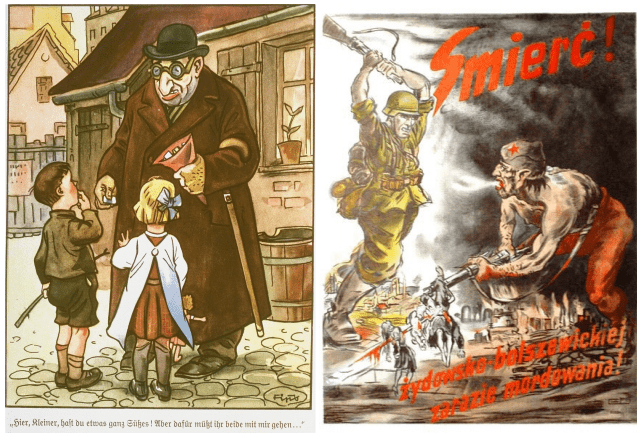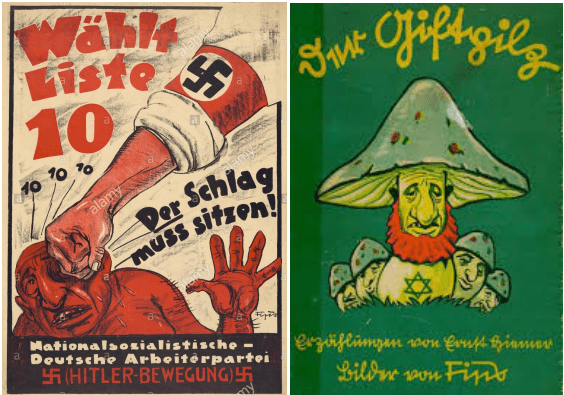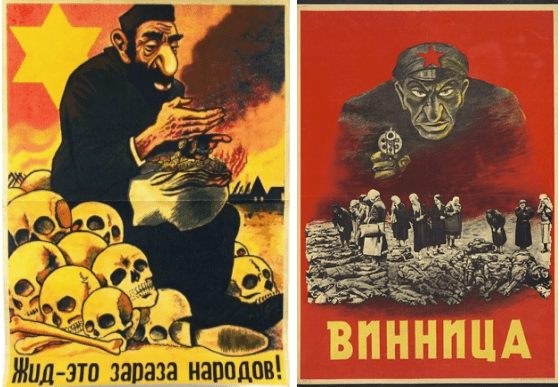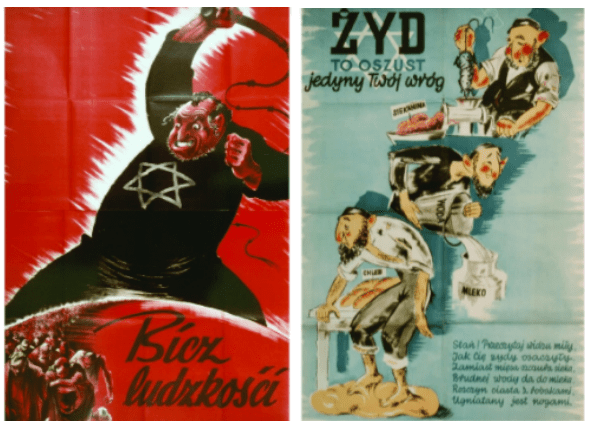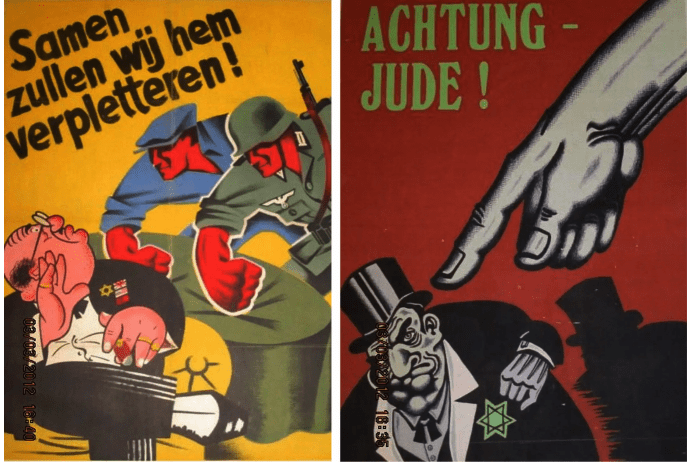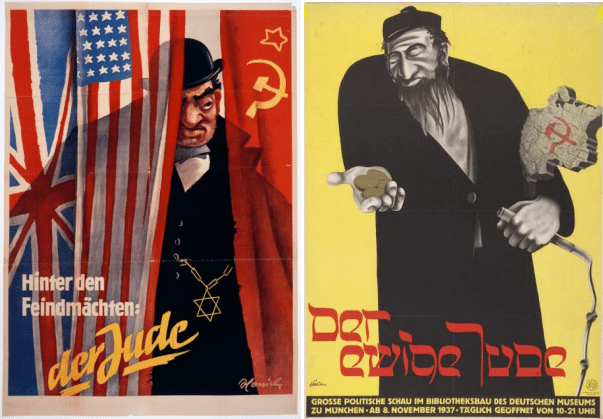Media Literacy Final Lesson Plan
km-spradlin-wwii-propaganda-lesson-1
Kim Spradlin
Title of Lesson: The Diary of Anne Frank: Analyzing anti-Jewish propaganda
Grade Level: 8th grade
Class: English Language Arts
Length: The second of two 50 minute propaganda lessons as part of their reading of The Diary of Anne
Frank play.
Background: The students would have already received some introductory information about WWII and
the Holocaust, so my two lessons are intended to focus specifically on some of the propaganda the
Nazi’s used to scapegoat the Jewish people and eventually carry out their plan to annhilate the entire
race.
Here is the link to the slideshow from Lesson #1 so you can see the content the students would have
received from the first lesson in this two part mini-unit.
https://docs.google.com/presentation/d/1VNqFJkwNPt-6RUCSkVcAqpCH6u6zkNOQXnIZl5JbmJs/edit?u
sp=sharing
Standards:
CCSS.ELA-LITERACY.SL.8.2
Analyze the purpose of information presented in diverse media and formats (e.g., visually, quantitatively,
orally) and evaluate the motives (e.g., social, commercial, political) behind its presentation.
CCSS.ELA-LITERACY.RI.8.7
Evaluate the advantages and disadvantages of using different mediums (e.g., print or digital text, video,
multimedia) to present a particular topic or idea.
Lesson 2 of 2: Analyzing Anti-Jewish Propaganda
Remind the students about the propaganda I would have shown and explained to them yesterday: pages
from children’s books, the board game, newspapers, posters, etc. (Powerpoint #1)
Opening Activity: Show students the following image. It shows an anti-Jewish poster from Nazi
Germany that they likely won’t understand very well. But there are strong primary colors and imagery that
should intrigue them.
Give the students about three minutes to jot down all of their first impressions as they view the image.
They can write individual words, descriptions, questions, etc. They just need to get their first thoughts
and impressions down on paper.
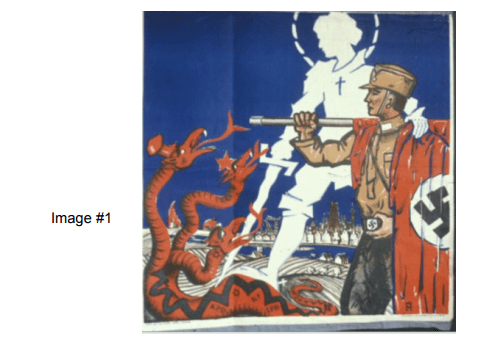
Ask students what they see in the image? Wait for multiple responses. (They may use their reaction
notes to help them get started.)
Then ask some or all of these follow up questions:
1. What is the general image (very broad descriptions with no analysis)
2. What specific details do you see? (List them: two people, snakes, bold colors, swastika, sword, etc.)
3. What symbols, key words or well known images are used?
○ What might the snake in the lower left represent?
○ Who or what is the white figure in the middle?
○ Why is the middle figure white?
4. How is the Nazi soldier depicted?
5. Is there a connection between the white figure and the soldier?
6. What is the emotion conveyed by the poster?
7. Who is the audience for this propaganda? What are their values?
8. What is the message of the poster? What is it trying to accomplish?
9. Etc.
Wait for a few responses for each question, but do not provide the “answers.”
Hopefully through this questioning, students will start to see that the snakes are representing something
scary, maybe a connection to Satan. They should notice that the white represents something/someone
pure/good/chosen by God. And the soldier is depicted as strong and focused, draped in the flag of his
country, and supported or connected to the holy white figure in the middle whose hand is on the soldier’s
shoulder.
Then show students the second slide which dissects the image and gives more specific details and
background information. Obviously, I wouldn’t expect students to understand all the specific elements of
the image, but this shows them the kinds of things to look for
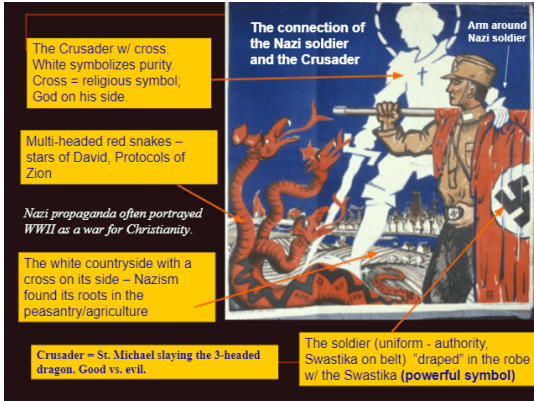
Do the same thing with this next poster. Show them the image and walk the students through similar
questions and see what they can identify
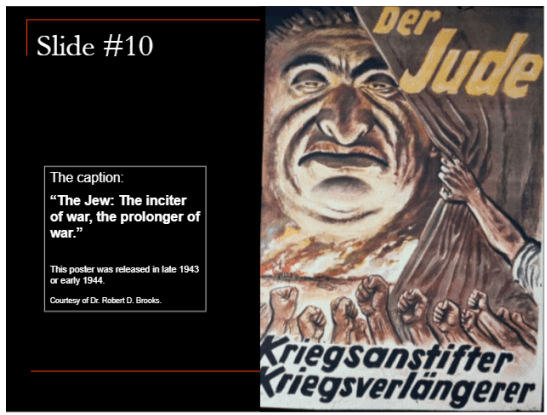
After hearing responses from the students, show them the next slide which provides some specific
details that will help students understand the analysis.
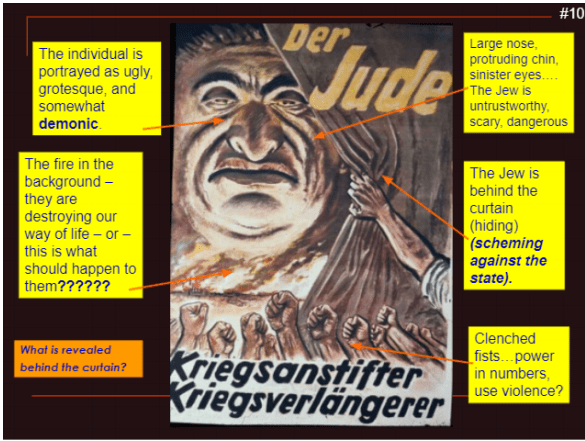
Next, ask the students to open up their own copies of the slideshow and have them partner up. Each pair
will use the following questions to analyze one of the posters in the slideshow. They will write the
answers to the questions on a sheet of paper. (Images can be found at after the lesson plan in this
document.)
Questions for Students to Answer:
1. What is the general image that you see in the picture? (very general and broad description w/out
understanding the details yet)
2. What specific details do you see in the image? List and describe them.
3. Which details might be most important?
4. What symbols, colors, key words or well known images do you see?
5. What emotion does the creator of the image want his/her audience to feel?
6. Who is the audience? What do you think they might value based on the image?
7. What is the message of the poster? What is it trying to accomplish? Is it trying to get the audience
to do something or believe something
8. What are the possible results or outcomes of this message?
9. What are the Nazi’s motives for creating this message? How might the Nazis personally benefit
from the audience believing this message?
10. Would a similar image have the same impact in today’s society? Why or why not?
Extension: If you have time, continue the lesson for one more day and have each pair
present their analysis to the class. Have classmates ask questions and/or comment on the
analysis presented by each pair. This will elicit more discussion and allow the teacher to see
how much students understand the process.
Below are the images that the students will analyze in pairs. (One image per pair of students,
or you can have students analyze more than one image.)
